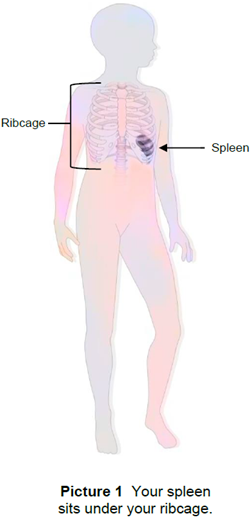Splenectomy

A splenectomy (spleh-nek-toh-mee) is a surgery to remove the spleen. The spleen is in the upper left side of the belly (abdomen) and is usually about the size of a fist (Picture 1). It filters blood and helps fight infections.
Most patients who need a splenectomy have:

- An enlarged spleen
- Sickle cell disease
- A ruptured or bleeding spleen
- Immune thrombocytopenia (ITP)
- Hereditary spherocytosis (HS)
About the Surgery
General anesthesia will be used. That means your child will be asleep during the surgery. The surgeon will decide the best surgery option for your child – laparoscopically or using the open method.
- Laparoscopic surgery – a few small cuts (incisions) are made in your child’s abdomen. Cameras and other tools are used to remove the spleen. This is the most common splenectomy surgery.
- Open method – one large incision is made in the abdomen.
Before Surgery
Your child will need certain vaccines (shots) before having a splenectomy. This may include pneumonia, meningococcal, and haemophilus B (HIB). These vaccines protect against certain infections that may be serious if you don’t have a spleen.
After Surgery
- Your child will be at a higher risk for infections. They will need to take an antibiotic each day for a period of time. Their doctor or health care provider will decide how long they need to take the antibiotic. This is usually at least 2 years but may be lifelong.
- Your child will need certain vaccines over time after their spleen is removed. Keep their vaccine records up-to-date.
- Tell your child’s school and anyone that will be caring for them about their splenectomy.
- Go to all of your follow-up appointments.
When to Call the Doctor
Call your child’s doctor or health care provider right away if:
- They have a fever of 101° Fahrenheit (F) or 38.3° Celsius (C) or higher.
- Remind them about your child’s splenectomy.
- Your child will need to go to their doctor’s or health care provider’s office or an emergency room.
- Each time your child has a fever, they may be treated with antibiotics.
- They have any signs of an infection. A fever is often the first sign of an infection, but others are:
- More tired than usual
- Throwing up (vomiting) or diarrhea
- Muscle aches
- Headache
- Chills
- Belly pain
- They will be traveling outside of the country.
- You have any other questions or concerns.
HH-I-256 • ©2005, revised 2024 • Nationwide Children's Hospital
